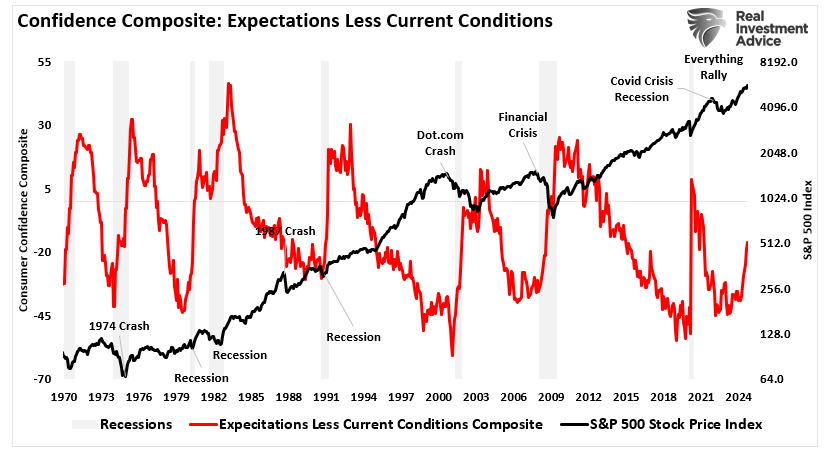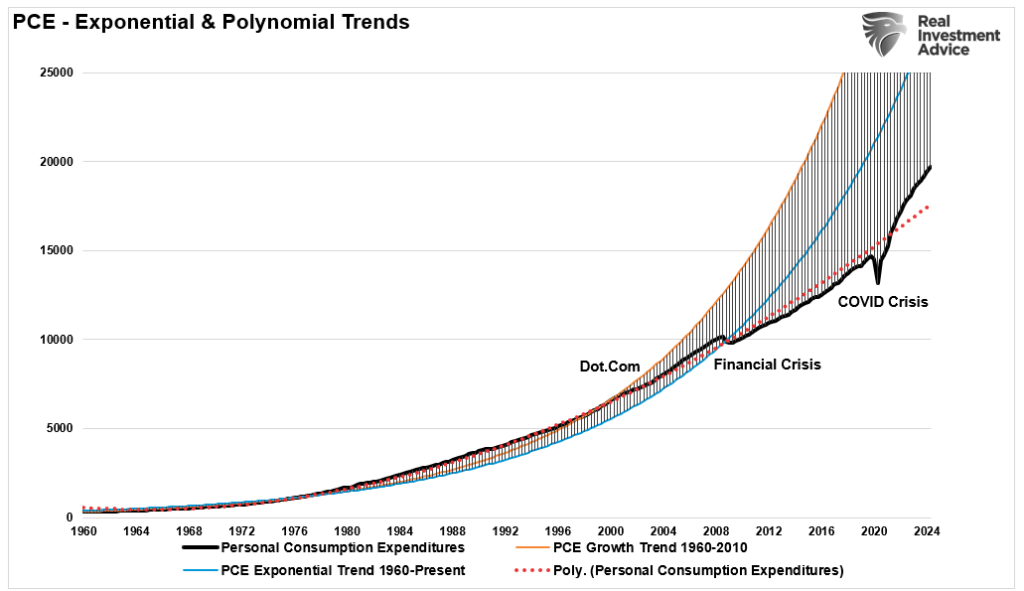The Bureau of Economic Analysis (BEA) recently released its second-quarter GDP report for 2024, showcasing a 2.96% growth rate. This number has sparked discussions among investors and analysts, particularly those predicting an imminent recession. There are certainly many supportive data points that have historically predicted recessionary downturns. The reversal of the yield curve inversion, the 6-month rate of change in the leading economic index, and most recently, consumer confidence warn of a recessionary onset. However, despite these warning signs, the U.S. economy continues to show resilience, defying many bearish forecasts. This article will explore the recent GDP report, the risks to continued growth, and potential investing opportunities. Defying
Topics:
Lance Roberts considers the following as important: 9) Personal Investment, 9a.) Real Investment Advice, Bear Market, Economics, Featured, Investing, Lance Roberts, newsletter, Recession, S&P 500, S&P 500
This could be interesting, too:
Nachrichten Ticker - www.finanzen.ch writes Die Performance der Kryptowährungen in KW 9: Das hat sich bei Bitcoin, Ether & Co. getan
Nachrichten Ticker - www.finanzen.ch writes Wer verbirgt sich hinter der Ethereum-Technologie?
Martin Hartmann writes Eine Analyse nach den Lehren von Milton Friedman
Marc Chandler writes March 2025 Monthly
The Bureau of Economic Analysis (BEA) recently released its second-quarter GDP report for 2024, showcasing a 2.96% growth rate. This number has sparked discussions among investors and analysts, particularly those predicting an imminent recession. There are certainly many supportive data points that have historically predicted recessionary downturns. The reversal of the yield curve inversion, the 6-month rate of change in the leading economic index, and most recently, consumer confidence warn of a recessionary onset.

However, despite these warning signs, the U.S. economy continues to show resilience, defying many bearish forecasts. This article will explore the recent GDP report, the risks to continued growth, and potential investing opportunities.
Defying Recession Calls: The Resilient U.S. Economy
Numerous market analysts have warned of an impending recession since early 2023, citing several factors: rapid rate hikes by the Federal Reserve, high inflation, and growing geopolitical risks. Yet, the Q2-2024 GDP growth of 2.96% suggests the U.S. economy is holding up better than expected. That resilience is particularly evident in consumer spending, which remains strong despite persistent inflation and higher interest rates. Currently, Personal Consumption Expenditures (PCE), which comprises about 70% of the GDP report, continue to be well above the polynomial growth trend.

Given PCE’s rather significant impact on the GDP report, a recession remains unlikely unless spending slows markedly.

Several aspects of the GDP report highlight the economic strength that has caught many bearish forecasters off guard:
Furthermore, the labor market remains supportive of economic growth. Yes, as shown, employment growth has slowed substantially following the “re-hiring” surge after the pandemic-related shutdown. However, as demand in the economy normalizes, employment growth is returning to its long-term growth trend. The chart below shows the 3-month average growth rate of hiring. As noted, employment growth has slowed but remains in growth mode. Until that 3-month average approaches zero job growth, the risk of a recession remains muted.

Lastly, business investment, another contributing factor to the GDP calculation, doesn’t support the recessionary expectations. Although business investment has been somewhat uneven and certainly weaker following the post-pandemic surge, there are signs that companies are still expanding. At nearly 5% annualized, private investment is not near levels normally associated with an economic recession.

These elements, all part of the last GDP report, suggest that predictions of an impending recession may have been overly pessimistic, at least for now. We will continue to monitor this data, and when it begins to approach levels normally associated with recessionary outcomes, we will warn our readers accordingly.
However, the implications for the stock and bond markets are clear for now.

Market Reactions: Why Investors Are Optimistic
Unsurprisingly, financial markets reacted positively to the latest GDP report, viewing it as evidence that the economy has avoided a recession from a period of elevated interest rates. That optimism has been particularly evident in the stock market, where equities have climbed on the back of positive consumer data.
A notable example is the recent surge in economically sensitive sectors of the market. As noted recently by Sentiment Trader:
“When 90% of cyclical sub-industry groups close above their respective 10, 20, 50, 100, and 200-day moving averages for the first time in six months, and the S&P 500 is within 2% of a five-year high, the world’s most benchmarked index displayed solid returns and consistency across all time horizons. Over the following three months, the S&P 500 advanced 81% of the time, achieving 13 consecutive gains since 1992.”
Most notably, growth-oriented sectors outperformed the S&P 500 over the subsequent year.

Unsurprisingly, as the risk of recession remains low, growth stocks have outperformed high-dividend “defensive” stocks. This is because economic growth provides support for earnings growth. Over the last year, analysts have continued pushing estimates higher into 2025, favoring stocks dependent on faster earnings growth rates.

Since investors are willing to “pay up” for future earnings, valuations have risen sharply.

As we discussed recently, the overall stock market is trading on optimism the Federal Reserve will continue to cut rates. With inflation coming down and growth remaining positive, many investors are betting on a scenario where the economy avoids a recession entirely. This “soft landing” narrative has propelled the S&P 500 and other indices despite many recessionary concerns.

Risks to Continued Economic Growth
Despite the Fed’s intervention, several risks to economic growth remain. The Q2 GDP report, while positive, revealed certain vulnerabilities that could threaten future growth, even with lower rates.
1. Weakened Business Investment
Business investment has slowed in recent reports, and as noted above, is a direct input into the GDP report. While lower borrowing costs will encourage some companies to expand, sectors like manufacturing and construction remain constrained by global supply chain issues and external demand. Additionally, as noted in the NFIB Small Business report, businesses may become more reluctant to invest significantly if the economy slows further or the upcoming election outcome suggests higher taxes and more regulations are forthcoming.

2. Housing Market Still Under Pressure
The housing market, one of the most interest-sensitive sectors, has been battered by high mortgage rates. The Fed’s rate cut will provide some relief, but it may not be enough to fully revive housing demand. With mortgage rates still elevated by historical standards and home prices high, affordability remains an issue for many potential buyers. Therefore, while we may see a slight pickup in housing activity, the overall impact of the rate cut on the housing market could be limited.
3. Consumer Spending Could Slow
Although consumer spending remained strong in Q2, higher consumer debt levels—particularly credit card debt—are an increasing concern. While lower interest rates will ease the burden for some borrowers, the overall level of consumer debt remains high. As the labor market cools and wage growth moderates, consumer spending could slow in the coming quarters, especially if inflation continues to pinch household budgets. Notably, PCE as a percentage of GDP has remained relatively stagnant since 2010 despite a significant surge in household debt levels.

Conclusion
I don’t disagree there are many reasons to be concerned about the economy currently. The Government is clearly spending like a “drunken sailor” on pet projects that don’t produce long-term economic prosperity. Geopolitical risks remain along with upcoming election risks that could significantly change the landscape for taxes and regulations.
However, while it is easy to focus on those risks as a reason “not to invest,” the Q2 GDP report continues to provide evidence that undermines many of the “doom and gloom” predictions for the U.S. economy.
At least for now.
Will that eventually change? Absolutely. There will be a recession at some point in the future, whether in six months or three years. However, if we focus on sectors and asset classes that can perform well in both slow-growth and inflationary environments, investors can navigate the current landscape and capitalize on opportunities, even as some analysts continue to warn of recession risks.
Importantly, when a recession approaches, the market has a long history of letting investors know.
Sources:
- Bureau of Economic Analysis (BEA) – Q2 2024 GDP Report
- Federal Reserve Economic Data (FRED)
- U.S. Treasury – Bond Yield Data
The post GDP Report Continues To Defy Recession Forecasts appeared first on RIA.
Tags: Bear Market,Economics,Featured,Investing,Lance Roberts,newsletter,recession,S&P 500
